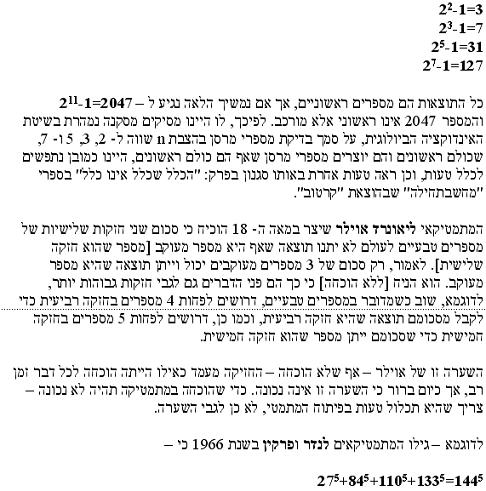Dr. Avraham ben Ezra
Direct link to this page: https://www.hayadan.org.il/benezrabioint.html
Biological induction: today the sun rose, yesterday the sun rose, the day before yesterday the sun rose, and so on every day looking back as far as our knowledge reaches.
Conclusion: Tomorrow the sun will rise.
Mathematical induction: if in the test for n=1 and n=2 the mathematical rule written when it includes n (a natural number) is true, and in addition, assuming that the rule is true for n it is proven that it is also true for n+1, then the written rule is Right.
That is to say, in mathematics, experience is not a proof, and a pure mathematical proof is required.
Sometimes it seems to those who are not familiar with the theory of mathematics, that mathematicians pile on themselves unnecessary difficulties beyond what is necessary, because if a certain equation is correct, or a certain rule is correct, regarding a very long series of private cases - it is better to accept the rule [or the equation] as wise, even If the pure proof is rather difficult and in fact not known at all.
For example, Marsan numbers [Marin Marsan, a French mathematician who created in the seventeenth century], whose general form is: 2n-1, where n is a natural number. Let us test a hypothesis that when n is a prime number, then the corresponding Marsan number is also prime.
[A natural number is a positive and whole number. A prime number is a natural number that is not divisible (without a remainder) except by itself and 1, as opposed to a complex number that is divisible into several numbers. Of course, every even number except 2 is also complex].
Examining the above hypothesis, we get positive results as follows:
Which contradicts Euler's hypothesis, because here the sum of four powers to the fifth power gives a number that is a fifth power.
Below is an explanation of how it is possible to create an equation that will surprise the spring only after a large number of attempts, as arbitrary as we want.
Let's examine the equation below:
And check, what is the value of y for x equals 0, 1, 2, etc.
We will prove that for x=0 we get y=10, and surprisingly also for x=1 x=2 x=3 x=4
The same results are obtained - y=10.
We should not conclude that even further, for natural numbers, the same result will be obtained, because this is already violated for x=5.
The reason for this lies in the mathematical fact that the same equation can also be written like this:
. y=10+x[(x-1)(x-2)(x-3)(x-4)]
And from this it is clear that for all values of x from zero to 4 in whole numbers the result is one y=10, and this in light of the resetting of the complex term of the equation in all these cases. And of course with the same method, if we want to write an equation in which by placing x=0 to x=1000000 in whole numbers, all the results will be y=10 - there is nothing simpler than that, and here is the equation:
.y=10+x[(x-1)(x-2).. ..(x-1000000)]
Regarding all the values zero to 1000000 in whole numbers, all the results will be y=10, and it is clear that for any value of x greater than 1000000 the value of y will be different from 10, and we will not be able to contain the inference here according to natural induction at all...
The math genius
https://www.hayadan.org.il/BuildaGate4/general2/data_card.php?Cat=~~~864195693~~~133&SiteName=hayadan


